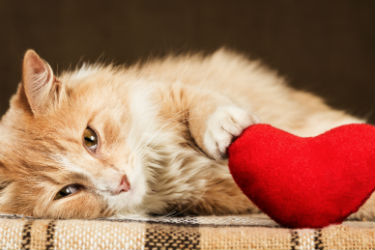Respect the Cat: Other Ways to Show Your Love

When a client thinks their cat may have a health problem because it shies away from being hugged or petted, they may be worrying unnecessarily. The animal may not be ill; it could just be a cat that doesn’t like being loved on!
There are some cats that will accept petting even though they don’t like it. However, their tolerance of being touched typically only lasts for a short while. When at the receiving end of the lashing claw, the attack always seems to come out of the blue, but it is actually not too difficult to determine when the cat has decided that they have had enough!
Warning Signs that Your Cat Doesn’t Like Being Petted
Clients should know that as their pet becomes uncomfortable with being petted, it will try to communicate that it wants them to stop. The cat’s message is a warning that will precede the attack. The owner needs to pay attention and stop touching the animal if they observe any of the following signs:
- Ears laid back
- Slowly swishing tail that changes into a quickly lashing tail
- Growling or vocalizing
- Narrowing of eyes
- Twitching skin
- Whiskers pulling forward
- Stiffening of body
- Pulling away from the hand that is petting them
- Trying to jump down or away from owner.
Ways to Show a Cat Love without Touching It!
Even though some cats don’t like being handled, that doesn’t mean that they don’t enjoy the company of their people. Advise clients that they can show their pet they love it through ways such as the following:
#1. Toys!
Cats are naturally playful, but can become bored. Providing them with toys and activities that entertain and pique their interest will not only amuse them, but will also help keep them active and healthy! Look for ones that will:
- Stimulate their senses, such as:
- Crinkle or belled balls
- Catnip pillows
- Treat-dispensing toys
- Encourage hunting behaviors with:
- Feathered toys
- Squeaking mice toys
- Increase activity levels by providing, for instance:
- Cat tunnels
- Cat towers
- Exercise wheel
- Allow for interaction between owner and animal, such as with a:
- Laser light pointer
- Feather boa teaser
- Prey wand.
Choose a toy that is:
- Tear- and chew-resistant
- Too large to be swallowed
- Free of little add-on parts that can come off and be swallowed.
#2. Plants!
Both wild and domestic outdoor cats eat plants as a part of their diet. Indoor cats seeking greens sometimes eat house plants that are not good for them, so having a feline-friendly green plant of their own to distract them from nibbling on other inedible plants could be a double benefit! Plants not only aid digestion and provide nutrients, but they may also help to rid the animal of hairballs. Common greens that cats can safely enjoy include:
- “Cat” grass, typically a mixture of oat, rye, barley, and wheat grasses
- Catnip
- Parsley
- Clover.
Remind clients that if the pot is big enough, their cat may have the urge to dig in the dirt and use it for a litter box. Ways to keep them out of a potted plant include covering the exposed soil with:
- Rocks
- Aluminum foil
- Strips of duct tape
- Strips of double-sided tape.
#3. Scratching Post!
Providing a scratching post will benefit both owner and animal! Cats love to scratch for a multitude of reasons, including:
- Grooming their claws to remove the worn-down outer sheath
- Stretching out their spine
- Marking their territory.
Whatever the reason, scratching can get them into trouble when it causes damage to household furnishings, so having a scratching post available will keep both owner and cat happy!
When choosing a scratching post, remind clients that:
- Cats like to scratch both horizontally and vertically
- Post must measure long enough for the cat to stretch to its full length and sink in its claws
- Note: most store-bought scratching posts are too short
- Base must be weighted or wide enough to not tip over or wobble
- Surface of scratching post should be rough and made of things such as:
- Wound sisal rope
- Back side of carpeting
- Tree stump or limb covered in bark
- Set the post in an area the cat will frequent and encourage its use by:
- Sprinkling catnip on the post
- Sticking bits of dried food between the sisal rope
- Playing with a toy next to the post
- Rewarding the cat with praise or a treat whenever it touches the post.
Clients of cats that don’t like being picked up and loved on should not worry. Cats have unique personalities, and their pet is just being who he is.
Help Your Clients Help Their Pets
At Covetrus, we believe the more information veterinarians provide clients, the more likely their clients will return. Here’s some additional information that may be of interest to your clients:
Covetrus has additional information that will help feline clients understand their pets’ needs, contact us online or at 855.724.3461.
Careers
Are you looking for a place to let your talents shine? At Covetrus, we help our practitioner customers better serve their patients and take pride in providing the best customer experience possible. Search our open positions to see our available opportunities.
Newsletter
Stay current with what’s going on with Covetrus, subscribe to receive our newsletter and email communications. Subscribers will receive the latest information in practice management, sales and marketing, animal health, and more.


Leave a comment